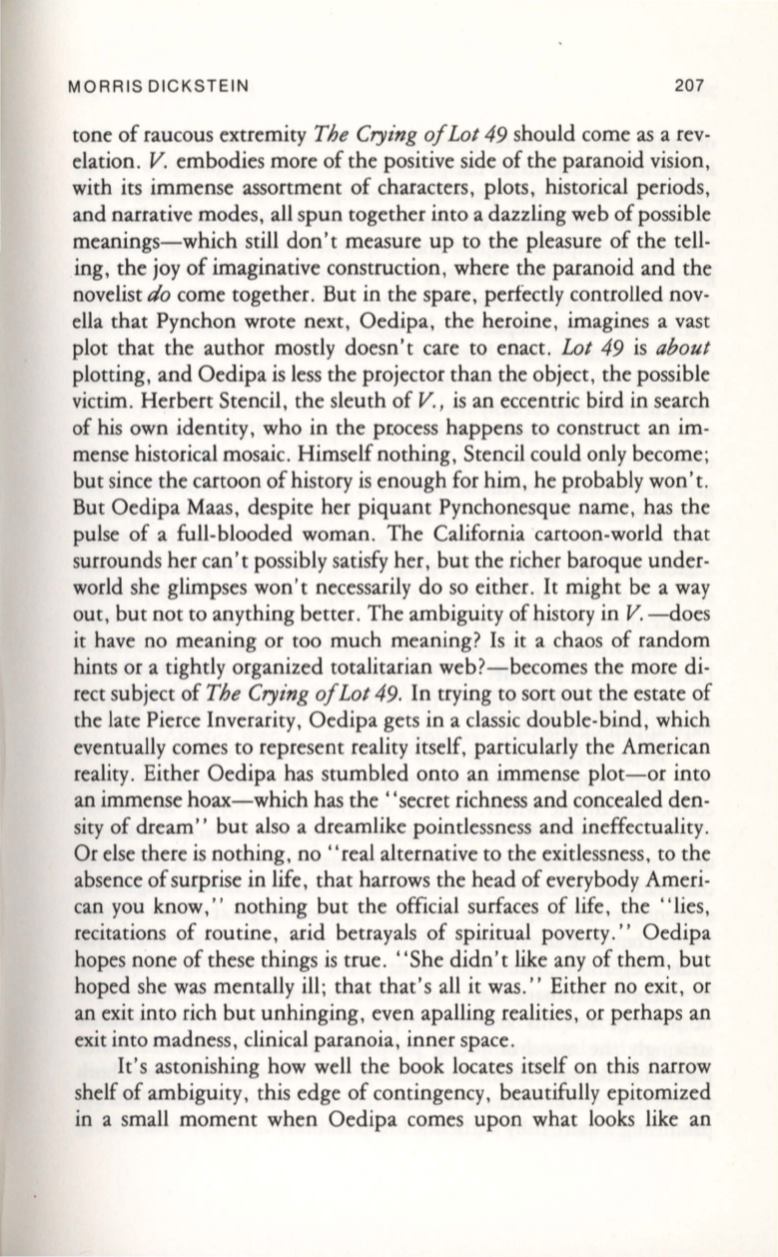
MORRIS DICKSTEIN
207
tone of raucous extremity
The
Crying
ofLot
49 should come as a rev–
elation.
V.
embodies more of the positive side of the paranoid vision,
with its immense assortment of characters, plots, historical periods,
and narrative modes, all spun together into a dazzling web of possible
meanings-which still don't measure up to the pleasure of the tell–
ing, the joy of imaginative construction, where the paranoid and the
novelist
do
come together. But in the spare, perfectly controlled nov–
ella that Pynchon wrote next, Oedipa, the heroine, imagines a vast
plot that the author mostly doesn't care to enact.
Lot
49 is
about
plotting, and Oedipa is less the projector than the object, the possible
victim. Herbert Stencil, the sleuth of
V.,
is an eccentric bird in search
of his own identity, who in the process happens to construct an im–
mense historical mosaic. Himself nothing, Stencil could only become;
but since the cartoon of history is enough for him, he probably won't.
But Oedipa Maas, despite her piquant Pynchonesque name, has the
pulse of a full-blooded woman. The California cartoon-world that
surrounds her can't possibly satisfy her, but the richer baroque under–
world she glimpses won't necessarily do so either.
It
might be a way
out, but not to anything better. The ambiguity of history in
V.
-does
it have no meaning or too much meaning? Is it a chaos of random
hints or a tightly organized totalitarian web?-becomes the more di–
rect subject of
The
Crying
ofLot
49. In trying to sort out the estate of
the late Pierce Inverarity, Oedipa gets in a classic double-bind, which
eventually comes to represent reality itself, particularly the American
reality. Either Oedipa has stumbled onto an immense plot-or into
an immense hoax-which has the' 'secret richness and concealed den–
sity of dream" but also a dreamlike pointlessness and ineffectuality.
Or else there is nothing, no "real alternative to the exitlessness, to the
absence of surprise in life, that harrows the head of everybody Ameri–
can you know," nothing but the official surfaces of life, the "lies,
recitations of routine, arid betrayals of spiritual poverty." Oedipa
hopes none of these things is true. "She didn't like any of them, but
hoped she was mentally ill; that that's all it was." Either no exit, or
an exit into rich but unhinging, even apalling realities, or perhaps an
exit into madness, clinical paranoia, inner space .
It's astonishing how well the book locates itself on this narrow
shelf of ambiguity, this edge of contingency, beautifully epitomized
in a small moment when Oedipa comes upon what looks like an


